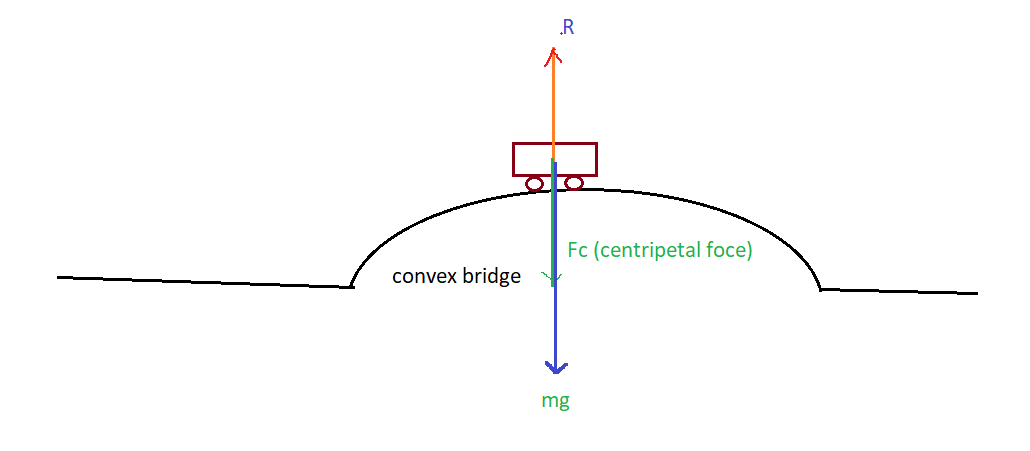
A car when passes through a convex bridge exert a force on it which equals to:
A.
B.
C.
D. None of the above
Answer
405.3k+ views
1 likes
Hint: For a car moving on a curved bridge, the car will exert the normal force on the bridge as it moves through it. The weight of the car will be acting downwards, opposite to the normal reaction. Then the difference of the weight and normal reaction will provide the necessary centripetal force to the car.
Complete step by step solution:
Let r be the radius of the convex bridge and let us now draw the free body diagram of the car on the bridge.
Following is the diagram showing the forces acting on the car.

We can write from the diagram.
Here,
The centripetal force is given by the following formula.
Here,
Putting this value in equation (1), we get the following expression.
Therefore, the force exerted by the car when it passes through a curved bridge is given below.
Hence, the correct option is (C)
Note:
The force exerted by the car when it passes through the concave bridge is given below.
A body doing circular motion is always acted by a force called centripetal force and the direction of this force is always towards the center.
As the radius of the curved path decreases the magnitude of centripetal force increases.
Complete step by step solution:
Let r be the radius of the convex bridge and let us now draw the free body diagram of the car on the bridge.
Following is the diagram showing the forces acting on the car.

We can write from the diagram.
Here,
The centripetal force is given by the following formula.
Here,
Putting this value in equation (1), we get the following expression.
Therefore, the force exerted by the car when it passes through a curved bridge is given below.
Hence, the correct option is (C)
Note:
The force exerted by the car when it passes through the concave bridge is given below.
A body doing circular motion is always acted by a force called centripetal force and the direction of this force is always towards the center.
As the radius of the curved path decreases the magnitude of centripetal force increases.
Recently Updated Pages
Master Class 9 General Knowledge: Engaging Questions & Answers for Success

Master Class 9 English: Engaging Questions & Answers for Success

Master Class 9 Science: Engaging Questions & Answers for Success

Master Class 9 Social Science: Engaging Questions & Answers for Success

Master Class 9 Maths: Engaging Questions & Answers for Success

Class 9 Question and Answer - Your Ultimate Solutions Guide

Trending doubts
State and prove Bernoullis theorem class 11 physics CBSE

Who built the Grand Trunk Road AChandragupta Maurya class 11 social science CBSE

1 ton equals to A 100 kg B 1000 kg C 10 kg D 10000 class 11 physics CBSE

State the laws of reflection of light

One Metric ton is equal to kg A 10000 B 1000 C 100 class 11 physics CBSE

Difference Between Prokaryotic Cells and Eukaryotic Cells




